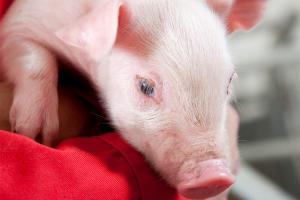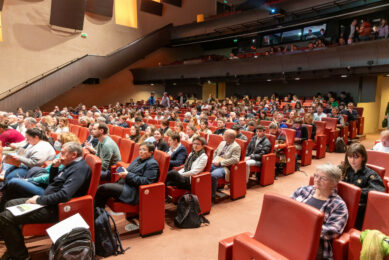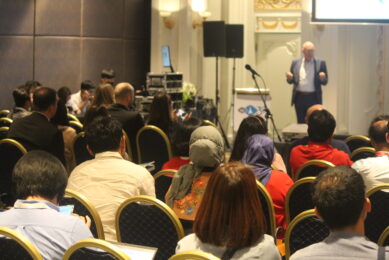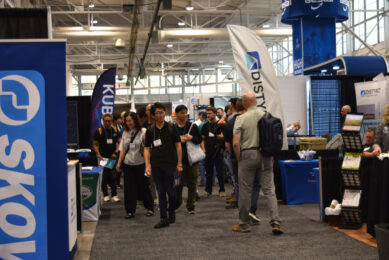Extra heating reduces mortality of newborn pigs

Providing extra heat in the farrowing house can save the lives of many newborn pigs. Research at Aarhus University shows how underfloor heating can combine with room temperature to prevent hypothermia and deaths.
Newborn piglets are relatively mature at birth compared to many other newborn mammals. However, many piglets succumb to hypothermia in their first few hours of life, as they have almost no energy reserves with which to keep warm. If a newborn piglet becomes chilled, it is weakened and has little strength to fight any problems that may subsequently arise. The piglet may die of starvation, disease or may be crushed to death by the sow.
It is therefore important to prevent neonatal piglets from being chilled. Pig farmers already practise heating a separate creep area in the farrowing pen away from the sow, which the piglets gradually learn to use from when they are one to two days old.
Immediately after birth the piglets have no benefit from this source of heating, as they instinctively seek the sow’s udder during the critical first few days of life. Establishment of either heating or radiant heat in the birthing area can, however, help to ensure that there is adequate heating so they avoid getting chilled.
However, the floor should only be heated for the minimum period necessary – both for economic reasons and to ensure it does not become unbearably hot for the sow. Scientists from Aarhus University therefore studied the effect on piglet body temperature of the duration (12 or 48 hours after birth) of underfloor heating in the farrowing pen in combination with different air temperatures in the farrowing house (15°C, 20°C or 25°C). The scientists also looked at how much the pigs used the heated creep area in the farrowing pen.
Mortality higher in a cool room
The study showed that the probability of piglets dying before they managed to get their first drink of life-giving colostrum from the sow was nearly seven times higher at an ambient temperature of 15°C compared to 25°C, despite the floor surface being heated to about 34°C.
When the farrowing pen was heated to either 15°C or 20°C, the body temperature of the piglets in the first postnatal half hour dropped by more than at a room temperature of 25°C. Their body temperature also took longer to return to normal when the room was either 15°C or 20°C compared to 25°C. With an air temperature of 15°C the situation started to become critical. The piglets’ body temperatures were dangerously close to a level that can affect their metabolism and ability to regulate body heat.
Heated floor
Heating the floor in the area where the pigs are born is a method that is used to keep neonatal piglets warm – but how long a period after birth do you need to keep the floor warm? The study revealed that 12 hours with heated flooring gives almost as good a result as 48 hours with heated flooring in terms of piglet cooling – regardless of the air temperature. This means an energy saving if you can limit heating to 12 hours after birth.
In the first hours after birth the piglets do not normally use the creep area in the farrowing pen since they are strongly attracted to the sow’s udder. This is opportune since it increases their chances of getting the necessary colostrum. During their first few days of life, the piglets will gradually learn to look for alternative sources of heat to the sow – if such sources exist in the pen. In the study, the scientists observed that at low ambient temperatures the pigs were more likely to and did more rapidly seek out the creep area.
This may explain why heating the floor for 48 rather than 12 hours did not provide additional benefits. In fact, the probability of dying within the first seven days after birth was 1.6 times higher in litters with 48 hours of heating compared to 12. Maybe the pigs are more often trampled on or crushed to death when they are close to the sow or maybe the sow is heat-stressed if the heat is on for too long, which can indirectly affect piglet survival.
In the study, the piglets that were born into an air temperature of only 15°C were drawn to the warm creep area already 6-12 hours after the heating in the floor had been turned off. Nonetheless, only about half of the pigs sought the warmth of the creep area before they were two days old – even at an air temperature of 15°C. This shows that a heated area away from the sow is unable to meet the heat requirements of newborn pigs. Other solutions must be found, including floor or radiant heat in the birthing area in the first few hours of life combined with an elevated ambient temperature of up to 25°C in the farrowing pen around the time of birth.
“The time span when they need extra heat may be limited to the period when the piglets get their first colostrum, i.e. 6-12 hours after the birth of the first pig in the litter, depending on how long the delivery lasts,” says senior scientist Lene Juul Pedersen.
Other factors also have an effect on piglet mortality.
“Sow sickness, farrowing difficulties and piglet birth weight can all affect piglet survival,” says Lene Juul Pedersen.
Source: Janne Hansen, Aarhus University











